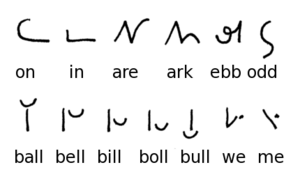Thomas Shelton (stenographer) facts for kids
Thomas Shelton (born around 1600 or 1601) was an English expert in stenography. He created a very popular system of shorthand writing used in Britain during the 1600s and 1700s. Shorthand is a way to write very quickly using special symbols instead of full words.
Contents
Who Was Thomas Shelton?
Thomas Shelton was born around 1600 or 1601. We don't know much about where he came from or his schooling. Some people thought he might be from a famous family in Norfolk, England.
During the English Civil War (1642–1649), Shelton supported the Parliament. He was also a Puritan, which was a type of Christian belief.
Shelton earned his living by teaching shorthand in London. He taught for about thirty years. During this time, he kept working on and improving his own shorthand systems. He knew about the shorthand system created by John Willis. Shelton used some of Willis's ideas, like using geometric shapes, to help create his own system. He sold his shorthand books from his home.
Shelton's Speedy Writing System
In 1626, Shelton invented a new shorthand system. He first published it in a book called Short-Writing. Later editions, starting in 1635, were called "Tachygraphy". This name comes from Ancient Greek words meaning "speedy writing."
In Shelton's shorthand system, each consonant had a simple symbol. These symbols sometimes looked a bit like the regular alphabet letters.
The vowels were shown by where the next consonant symbol was placed. For example, if the B symbol had the L symbol directly above it, it meant "ball." If the L symbol was below the B symbol, it meant "bull."
If the L symbol was top right of the B symbol, it meant "bell." If it was middle right, it meant "bill." If it was bottom right, it meant "boll." If a vowel was at the end of a word, a dot was placed in the right spot. There were also special symbols for vowels at the beginning of words. Other symbols were used for common word parts like prefixes (at the start of a word) and suffixes (at the end of a word). There were also symbols for groups of consonants.
One small problem with Shelton's shorthand was that it didn't always clearly show the difference between all vowels. For example, the symbols for "bat" could also mean "bait" or "bate." The symbols for "bot" could also mean "boot" or "boat." You had to figure out the correct word from the rest of the sentence.
However, a big advantage of his system was that it was easy to learn. Because of this, more than 20 editions of his "Tachygraphy" book were printed between 1626 and 1710. German versions were printed from 1679 to 1743, and a French version came out in Paris in 1681.
Many famous people used Shelton's shorthand. These included Samuel Pepys, Sir Isaac Newton, John Byrom, and US-President Thomas Jefferson. In 1650, the year he died, Shelton published another shorthand system called "Zeiglographia." But this system did not become as popular as his "Tachygraphy."
How Shelton's Work Influenced Others
Shelton's Tachygraphy system was used and changed by later shorthand creators. These included Thomas Arkisden, Theophilus Metcalfe, and Charles Aloysius Ramsay. Another person, Elisha Coles, adapted Shelton's "Zeiglographia" system.
Books About Thomas Shelton
- Alexander Tremaine Wright: Thomas Shelton, tachygrapher. London 1896.


